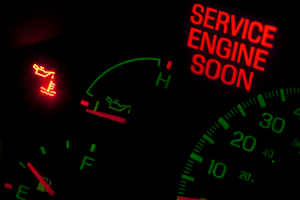Does your stomach drop every time that your check engine light illuminates on your dashboard? If that makes your heart skip a beat to even contemplate, then you’re definitely not alone.
A lot of the worry comes from the fact that your check engine light covers so many different issues from the fairly lightweight (e.g., loose gap cap) to major league car repair issues (e.g., an engine that’s misfiring).
The nice thing is that when you take your car in to All Around Auto Repair you can find out exactly what the underlying problem is.
Quickly Diagnosing with OBD-II Codes
 Ever since the mid 1990s (back in the days when MTV actually played music videos!) auto manufacturers have subsribed to a standardized method of listing car problems in general and check engine light issues in particular.
Ever since the mid 1990s (back in the days when MTV actually played music videos!) auto manufacturers have subsribed to a standardized method of listing car problems in general and check engine light issues in particular.
These standards are collectively known as OBD-II in the United States, and this stands for on-board diagnostics. The funny thing is that the first iteration of on-board diagnostics would only provide an unsophisticated “error” message known as an “idiot light” if something went awry.
Things have come a long way since those bad old days. The ASE-certified technicians at All Around Auto Repair use diagnostic tools (e.g., MaxScan) and a digital communications port to get real-time information about what’s potentially going wrong under the hood.
When you come in for car repair, technicians will check high-tech diagnostic tools under the steering column to get clued in to hundreds of different car issues you might be experiencing. There’s a OBD-II code for just about every one out there!
The check engine light – which could be orange, yellow, or even amber depending on your particular vehicle – could mean a variety of different things, but if the check engine light is blinking then that means you need to come in to All Around Auto Repair immediately for a check and car repairs.
Eight Common Check Engine Meanings
Presuming you’re not quite in dire straits yet, what could you check engine light mean if it simply stays on? A few of the top reasons for the check engine light staying on, essentially in ascending order of seriousness and cost of car repair, would be:
-Loose gas cap
-Evaporative emissions purge control valve
-Ingition coil needs replacing
-Thermostat needs replacing
-Oxygen sensor needs replacing
-Mass airflow sensor
-Poor fuel injectors
-Catalytic convertor needs replacing
As you can see, a lot of these problems will require car repair and aren’t necessarily intuitive to diagnose. When was the last time you saw someone slap their forehead and say, “of course, the evaporative emissions purge control valve!”.
Professional Diagnostics for Peace of Mind
The truth is that almost all of these problems require professional diagnosing. While the check engine light be temporarily pop on because of something trivial like high humidity, car owners ignore a check engine light that stays on or blinks at their own peril.
A lot of drivers understandably bury their heads in the sand and want to do anything but turn over in their mind what the problem could be. Fears of high car repair bills are a common reason why folks ignore the check engine light.
Definitely Deal with Problems Early On
Here’s the thing, though: What often starts out as a relatively minor problem can devolve into a major headache if not dealt with by an experienced mechanic.
Spark plugs, for instance, should be swapped out about every 30,000 miles, and forgoing that car repair can lead to a lot of unsavory problems: poor fuel economy, trouble accelerating, issues getting your car started, and a misfiring engine!
Don’t let a minor problem develop into a major headache. Get in touch with All Around Auto Repair and have ASE-certified technicians diagnose your auto issues early to avoid big car repairs down the road.

